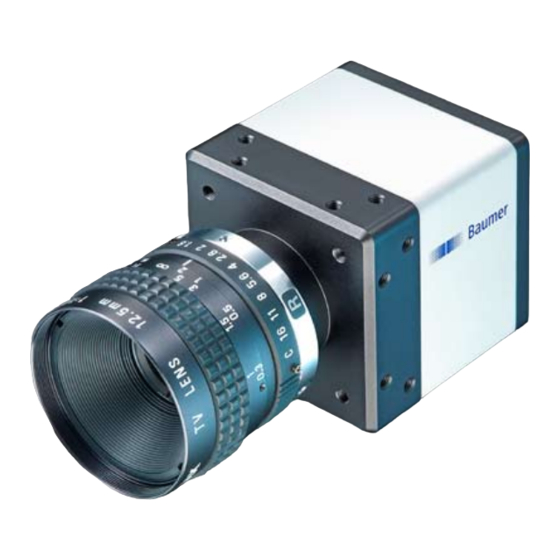Baumer SXC20 Podręcznik użytkownika - Strona 14
Przeglądaj online lub pobierz pdf Podręcznik użytkownika dla Aparat cyfrowy Baumer SXC20. Baumer SXC20 48 stron. Sxc series
cameralink cameras with truesense imaging
sensors
Również dla Baumer SXC20: Skrócona instrukcja obsługi (2 strony)

Timings:
A - exposure time
frame (n) effective
B - image parameters
frame (n) effective
C - exposure time
frame (n+1) effective
D - image parameters
frame (n+1) effective
E - earliest possible trigger
Image parameters:
Offset
Gain
Mode
Partial Scan
14
6.2.2. Trigger Mode
After a specified external event (trigger) has occurred, image acquisition is started. De-
pending on the interval of triggers used, the camera operates non-overlapped or over-
lapped in this mode.
With regard to timings in the trigger mode, the following basic formulas need to be taken
into consideration:
Case
t
< t
exposure
readout
t
> t
exposure
readout
6.2.2.1. Overlapped Operation: t
In overlapped operation attention should be paid to the time interval where the camera is
unable to process occuring trigger signals (t
exposures. When this process time t
external events again.
After t
has elapsed, the timing of (E) depends on the readout time of the current im-
notready
age (t
) and exposure time of the next image (t
readout(n)
formulas mentioned above (no. 1 or 3, as is the case).
In case of identical exposure times, t
tion.
Trigger
t
t
Exposure
Readout
TriggerReady
Flash
(1)
t
earliestpossibletrigger(n+1)
(2)
t
= t
notready(n+1)
exposure(n)
(3)
t
earliestpossibletrigger(n+1)
(4)
t
= t
notready(n+1)
exposure(n)
exposure(n+2)
). This interval is situated between two
notready
has elapsed, the camera is able to react to
notready
exposure(n+1)
remains the same from acquisition to acquisi-
notready
t
min
triggerdelay
t
exposure(n)
exposure(n+1)
t
readout(n)
t
notready
t
t
flash(n)
flash(n+1)
t
flashdelay
Formula
= t
- t
readout(n)
exposure(n+1)
+ t
- t
readout(n)
exposure(n+1)
= t
exposure(n)
= t
exposure(n+1)
). It can be determined by the
t
readout(n+1)
